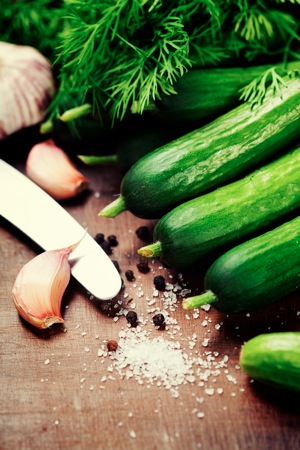
Embarking on a diet to repair leaky gut, or intestinal permeability, can be a daunting task. But with cultured vegetables on the gut-healing menu, the diet can also be fun and inventive. Culturing, or fermenting, is an ancient art of preserving various vegetables that not only imparts a zesty flavor but also creates beneficial enzymes, probiotics, and B vitamins, all of which enhance digestive health. Also, for such a restricted diet, fermented veggies add variety and convenience while capitalizing on in-season produce.
Why fermented vegetables on the leaky gut diet?
The intestines, considered the seat of the immune system, house trillions of bacteria that play a vital role in the health of the entire body and even the brain. Inflammation from bad diets, chronic stress, food intolerances, and other issues damage the lining of the intestine, causing it to become overly porous. This allows undigested foods, bacteria, yeast, and other pathogens into the sterile environment of the bloodstream. This is called leaky gut, or intestinal permeability. These pathogens trigger chronic inflammation, autoimmune disease, depression, anxiety, skin conditions, obesity, and other chronic disorders.
A leaky gut diet allows the gut to repair and regenerate by removing common inflammatory foods and focusing on nutrients and foods that help repair the intestinal lining. Cultured vegetables are an important component of a leaky gut diet because they act as powerful probiotics, helping to restore a healthy balance of bacteria, or flora, in your gut.
Our gut flora play very important roles in health, immunity, and even brain function. Beneficial gut bacteria help us absorb minerals and produce B vitamins and vitamin K2, which is necessary for optimal usage of vitamin D. They play a role in burning and storing fat and whether a person is prone to obesity. In recent years researchers have found gut bacteria play a significant role in mood and mental health.
How to make our own cultured vegetables
Health food stores carry one or more brands of genuinely fermented vegetables—they are cultured in a saltwater brine and do not contain vinegar, preservatives, or artificial colors. The most popular is Bubbies, which carries cultured cucumbers, cabbage (sauerkraut), and tomatoes. As awareness and popularity of cultured vegetables grows, new brands are popping up in the refrigerated section. You may find some made locally in your area.
However, it is easy and fun to make your own. You can find many recipes online, including at Cultures for Health, an online source for starters for many different types of cultured foods. You can culture almost any vegetable, and the process basically entails washing and chopping your vegetables, mixing with sea salt, covering in a saltwater brine, or mixing with a starter culture, placing in a large jar or fermenting crock, and letting time and natural bacteria do their magic during the next two days to three weeks, depending on the vegetable (the warmer the environment the quicker the process).
The result is a tart, tangy superfood for the gut. The finished product is ready to eat right out of the jar and can be stored for many months in a root cellar or refrigerator. Many people like to make large batches for grab-on-the-go veggies or as a condiment to their main dish.
For more information on how to make your own cultured vegetables, visit Cultures for Health, read Wild Fermentation, or simply Google for recipes and how-to videos.



Latest from the Blog
The Death of Red Dye #3
January 15, 2025What Is Red Dye No. 3? Red Dye No. 3, or Erythrosine, is a synthetic food color derived from coal tar. It was first approved by the FDA in the 1950s and quickly became one of the most popular artificial colors in food and cosmetics. Red Dye No. 3 was used in everything from candies, […] Read more
Latest from the Blog
Do You Know What Is In Your Protein Powder?
What’s Really in Your Protein Powder? Understanding the Risks Protein powders are a staple in many health-conscious diets, from athletes seeking muscle recovery to those simply aiming to boost their daily protein intake. With a wide variety of options available, choosing the right one can feel overwhelming. However, recent findings have raised concerns about what’s […] Read more